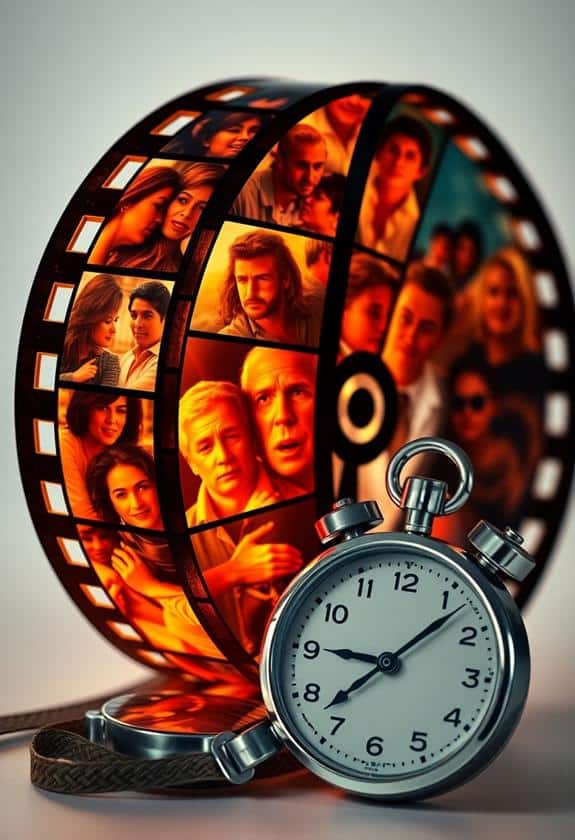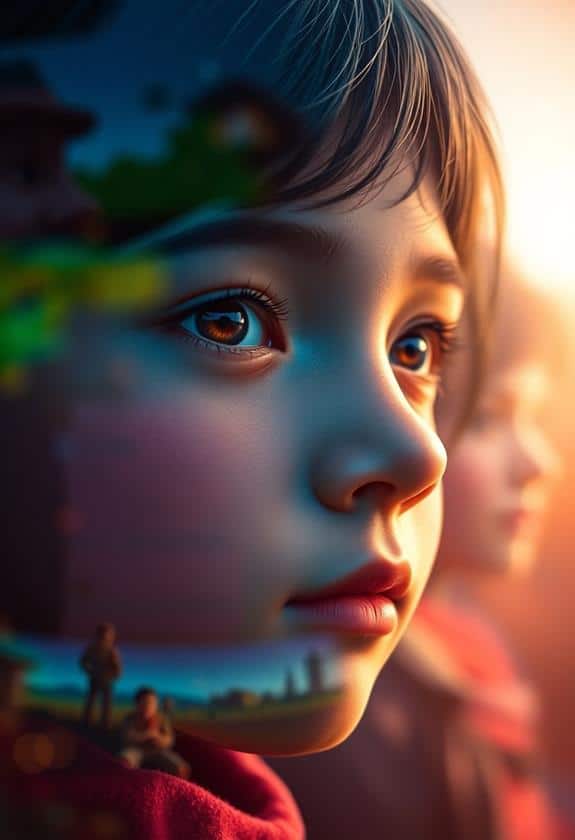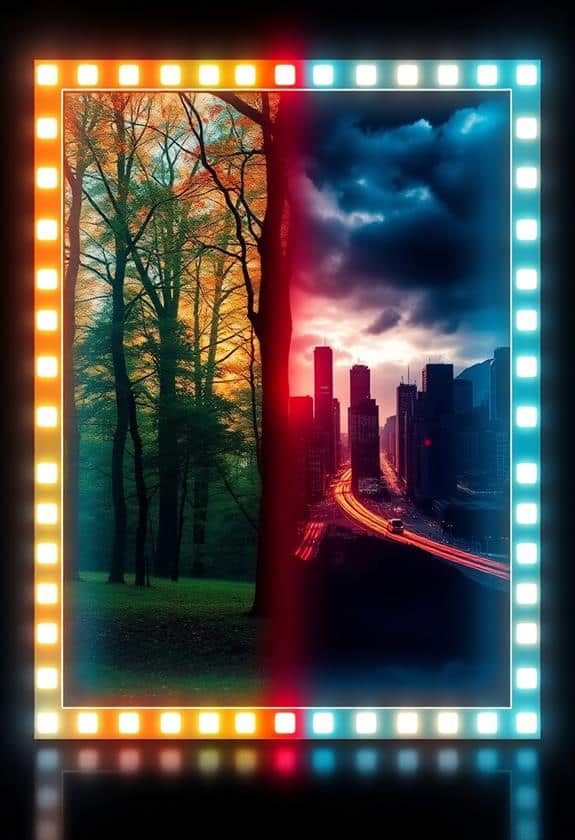Storytelling in short films is unique because it packs powerful emotions and vivid narratives into just a few minutes. You’ve got to make each moment count! With quick character backstories, you can connect instantly. Plus, clever visuals and sounds draw you in, creating an emotional punch. Remember that time you laughed at a serious scene? That’s the magic of humor! Short films often play with time or themes, leading to surprises that keep you guessing. As you explore different stories, you might find connections to your own life, making the experience even richer. There’s so much more waiting to inspire you!
Key Highlights
- Short films utilize brevity to convey deep emotions and complex narratives effectively within a limited timeframe.
- Focused character development quickly establishes relatable motivations and flaws, enhancing audience engagement.
- Innovative narrative structures, such as non-linear storytelling, surprise viewers and encourage active participation.
- Impactful visual storytelling through color, lighting, and composition influences audience perception and emotional response.
- Themes in short films provide deeper meaning, fostering connections and inviting diverse interpretations among viewers.
The Art of Brevity

In just a few minutes, a short film can convey deep emotions and complex narratives, proving the power of brevity in storytelling. You might be surprised at how much impact a few carefully chosen images and words can have. Think about it: a tiny story can spark big feelings, like joy or sadness, all while keeping your attention. With the right essential filmmaking equipment, such as a high-quality acrylic clapboard for smooth organization or a versatile dolly for dynamic shots, filmmakers can enhance their storytelling without overcomplicating their narrative.
When I first tried making short films, I learned the hard way that every second counts. I packed my ideas with too much fluff, thinking it’d make the story richer, but it only confused viewers. Then, I started trimming down my scripts, focusing on essential moments that really mattered. For instance, in one film, a simple glance between characters spoke volumes, showing their connection without a single word.
Focused Character Development

Crafting impactful short films requires not just brevity in storytelling but also a keen focus on character development. You want your audience to connect with your characters quickly, so each moment counts. Think about how you can reveal layers of their personality in just a few scenes. A well-developed character can drive the story and resonate deeply with viewers.
Here’s a simple table to help you remember key aspects of focused character development:
| Element | Description | Example |
|---|---|---|
| Backstory | Brief history that shapes them | A child who lost a pet |
| Motivation | What drives them to act | Seeking closure |
| Flaw | A weakness that makes them relatable | Fear of abandonment |
| Change | How they grow through the story | Learning to trust again |
| Connection | Relationship with others | Bonding with a new friend |
Emotional Engagement Techniques

To truly captivate your audience in a short film, emotional engagement techniques are essential. Think about how you feel when you connect with a character. You want your viewers to experience that same connection. One effective way to do this is through relatable situations. For example, showing a character facing a tough decision can resonate deeply. Remember when you had to choose between two friends? That tension can grip your audience’s hearts. Additionally, the right top microphones for filmmaking can enhance the audio quality, allowing every subtle emotional nuance to come through clearly.
Another technique is using music and sound to heighten emotions. A soft piano melody can evoke nostalgia, while a sudden silence can create tension. I once used a simple soundtrack in a school project, and my friends said it made them feel the character’s struggles more intensely.
Don’t underestimate the power of visuals either. Close-up shots can reveal a character’s emotions, making viewers feel like they’re right there with them.
And humor? It’s a great way to break the ice and make your audience feel comfortable. A light joke can transform a serious moment into something relatable. So, mix these techniques together, and you’ll create a film that not only tells a story but also touches hearts.
Innovative Narrative Structures

Exploring innovative narrative structures can elevate your short film from ordinary to extraordinary. Think about it: the way you tell your story can grab attention and keep viewers hooked. I remember struggling with a traditional beginning, middle, and end format. It felt safe but predictable, and I wanted to do more. So, I experimented with non-linear storytelling. Suddenly, I could reveal character backstories through flashbacks or start at the end and work my way back. This approach surprised my audience and made them think! Investing in affordable filmmaking gear can help you experiment with these unique storytelling techniques.
Another cool structure is the anthology style, where you tell several smaller stories linked by a common theme. It’s like a cinematic quilt, each patch highlighting different aspects of your main idea. You can even play with time, jumping between different moments to create suspense or mystery.
These innovative structures invite creativity and allow you to express your unique voice. So, don’t be afraid to step outside the box! Your short film can be a thrilling journey, and the right narrative structure can make it unforgettable. Remember, every great filmmaker was once scared to take that leap!
Impactful Visual Storytelling

Visual storytelling is a powerful tool that can convey emotions and ideas in ways words often can’t. It captures your audience’s attention and pulls them into a world where images speak volumes. Think about how a single glance can express happiness or sadness. In short films, you have a limited time to make an impact, so every frame counts!
To illustrate this, here’s a simple table that highlights how visuals can enhance storytelling:
| Visual Element | Emotional Impact |
|---|---|
| Color | Sets the mood; warm colors feel inviting, while cool colors can evoke calmness. |
| Lighting | Shadows can create tension, while bright lights can signal joy. |
| Composition | The arrangement of elements can direct attention and create focus. |
| Movement | Dynamic scenes can build excitement, while slow movements can convey intimacy. |
When you create a short film, remember that every shot is a chance to tell a story. By carefully choosing colors, lighting, and movement, you can evoke feelings that resonate deeply. So, don’t be afraid to experiment! Your passion for storytelling will shine through, making your film memorable.
The Power of Themes

The Power of Themes
Themes serve as the backbone of storytelling in short films, providing a deeper meaning and context to the narrative. When you think about it, every great story has a theme, whether it’s friendship, bravery, or even the struggle against loneliness. A well-crafted theme can also enhance the visual storytelling, much like how camera lens types can influence the mood and tone of a film. I remember creating a short film about a shy kid trying to make friends. The theme of connection drove the whole story, shaping every scene and dialogue. It’s amazing how a clear theme can guide your viewers’ emotions, letting them feel what the characters feel.
In short films, where time is limited, having a strong theme helps you convey complex ideas quickly. You can create a powerful impact in just a few minutes! Think about using relatable themes that resonate with your audience. Maybe it’s the journey of self-discovery or the importance of family. When you choose a theme, you’re not just telling a story; you’re inviting viewers into a shared experience, making them feel safe and understood.
Audience Interpretation

Every short film invites viewers to interpret its story in unique ways, and this interaction can profoundly shape their experience. When you watch a short film, you might find yourself connecting with characters or themes differently than your friends do. That’s the beauty of storytelling! For example, I once watched a short film about a lost dog. While my friend felt sad, I found hope in the dog’s journey home.
Clear audio can enhance how audiences connect with these narratives, as well, especially when using key microphones for filmmaking. This diverse interpretation is like a treasure chest, filled with different meanings waiting to be discovered. Sometimes, directors leave clues or hints, but it’s up to you to piece them together. Don’t be afraid to share your thoughts with others; discussing your interpretations can lead to fascinating conversations.
Cultural Reflection and Diversity

Short films often serve as mirrors reflecting the rich tapestry of cultures and experiences that shape our world. When you watch these films, you immerse yourself in different lives, traditions, and perspectives that might be completely new to you. Imagine being whisked away to a vibrant festival in India or a quiet family gathering in a small town in Mexico, all within just a few minutes. That’s the magic of short films!
They give you a glimpse into diverse cultures, allowing you to feel empathy and understanding for others. You might even recognize some of your own experiences, which creates a sense of connection. I remember watching a short film about a young girl maneuvering through life in a big city, and it reminded me of my own adventures.
Filmmakers often face challenges when exploring cultural themes, but their passion shines through. They want to tell authentic stories that resonate with viewers like you. So, next time you watch a short film, think about the different cultures and experiences it reflects. You might just find a new appreciation for the world around you and the stories waiting to be told. Who knows? You might even feel inspired to create your own!
Frequently Asked Questions
How Do Short Films Differ From Feature Films in Storytelling?
Short films differ from feature films mainly in length and focus. You’ve got less time, so every second counts! You’ll often dive straight into the action or emotion, crafting a powerful moment. Think of it like telling a joke; you want to get to the punchline quickly. In my experience, this challenge pushed me to be more creative and precise with storytelling, making every frame feel important. It’s a fun, rewarding puzzle!
What Are Common Themes Explored in Short Films?
In short films, you’ll often find themes like friendship, love, loss, and identity. These stories pack a punch in just a few minutes! For instance, I once made a short about a lost pet, and it really connected with viewers. It’s amazing how a small story can evoke big emotions. You’ll see filmmakers explore challenges we all face, making those brief moments feel relatable and impactful, sometimes even making you chuckle!
How Can Aspiring Filmmakers Create Impactful Short Stories?
If you want to create impactful short stories, start by focusing on a strong theme that resonates with you. Think about your own experiences; maybe it’s a friendship or a challenge you faced. Keep your characters relatable, and don’t forget to add a twist that leaves viewers thinking. Use visuals effectively—like showing emotions through expressions. Finally, remember, a little humor can brighten even the toughest topics! Your passion will shine through in your storytelling.
What Role Does Music Play in Short Film Storytelling?
Ah, music—the magic ingredient that can turn your short film from “meh” to “wow!” It’s like adding sprinkles to a cupcake; it makes everything better! When you choose the right tunes, you’re setting the mood, guiding emotions, and even foreshadowing events. Picture a tense scene with a heart-pounding score or a sweet moment softened by gentle melodies. Trust me, don’t underestimate the power of a well-placed soundtrack in your storytelling journey!
Are There Notable Short Films That Set New Storytelling Trends?
Absolutely, there are some short films that really shake things up! For instance, “Piper” by Pixar uses stunning visuals and minimal dialogue to tell a heartfelt story. It’s amazing how much emotion can come from just a few minutes. Another great example is “The Silent Child,” which brings awareness to deaf culture. These films show that storytelling doesn’t need to be long to leave a lasting impact. They inspire us to think outside the box!
Conclusion
So, next time someone says short films can’t pack a punch, just smile and think of all the powerful stories you’ve seen in just a few minutes. You’ve got the chance to plunge into unique characters, vibrant visuals, and themes that resonate. Remember, it’s not about how long the story is, but how deeply it connects. Filmmaking is a journey, and every frame counts! Keep creating, exploring, and sharing your voice—who knows what magic you’ll capture?




